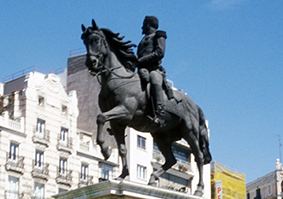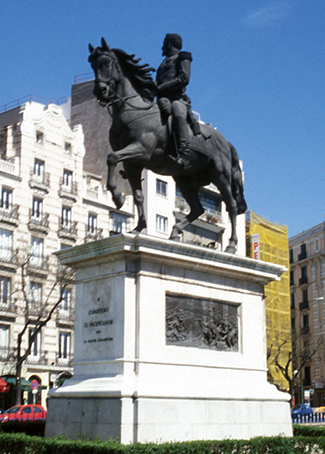General Espartero Monument

Public Art: General Espartero Monument
Sculptor: © Pablo Gibert Roig (1853-?)
Date Unveiled: 1886
Foundry: José Comas Blanch of Barcelona
Description: The bronze statue depicts Spanish hero General Baldomero Espartero the Prince of Vergara (1793-1879) on his well-endowed steed. The pedestal includes bronze reliefs of scenes from the Carlista War and the Agreement of Oñate in the fields of Vergara.
Inscription:
To Espartero, the Pacifier, 1839, The Grateful Nation
Location: General Espartero Monument is located on Alcala street, Retiro Park, Madrid, Spain.
It Is All About The Horse: To the keen observer you will notice that the testicles on the horse are exceptionally large. This did not go unnoticed amongst the Spanish admirers of the statue. Apparently, it is a common saying in Madrid, “Tiene cojones (he has balls) like Esperanto’s horse.” or “You have more balls than Espartero’s horse.”

Who Was Baldomero Espartero? Baldomero Espartero was a Spanish General, Prince and Prime Minister of Spain (three times). He was given the title of Prince by King Amadeo I in 1870 despite not being an heir to the throne. A great honour.
His greatest claim to fame was his role in the victory over the Carlists in 1839. The Carlists are a Spanish political movement seeking the removal of the Spanish throne. They were peeved about the succession laws. Traditionally in the Spanish Kingdoms if there were no male heirs the daughters could take the role of ruler.
In the 1700 Philip V, a French Bourbon prince, took the Spanish Throne. As it became a French royal house the succession rules (semi-Salicism) changed meaning no females were allowed to ascend the throne unless all male descendants of Philip became extinct. This resulted in the War of the Spanish Succession (1701–1714).
In 1789, during the reign of Charles IV the succession laws reverted back to the traditional system. The House of Bourbon were none too happy.
In 1830 it all came to a head when Ferdinand VII, whose only heir was a daughter, placed her ahead of Ferdinand’s brother who believed he was heir apparent. This triggered the Carlist Wars.
In 1833 Ferdinand VII died leaving his 3-year-old daughter Isabella II, Queen of Spain. The Carlists declared war. Baldomero Espartero headed the and defeated the Carlist’s in First Carlist War. He quickly rose through the ranks. His kind qualities during the war years and his radical ideas made him very popular amongst the lower and middle classes.
Following his military duties, he slipped into politics. He became Prime Minister of Spain three times. He became a folk hero among the workers. despite doing very little for Spain’s poor.
King Amadeus made him prince of Vergara. He died before he could ascend the throne and his titles were passed to his niece.
Tanyaa, The name of the general is not ESPERANTO but ESPARTERO
Greetings from Valparaiso Chile
Abel Osorio
Thank you, all fixed.